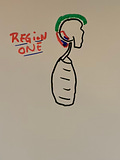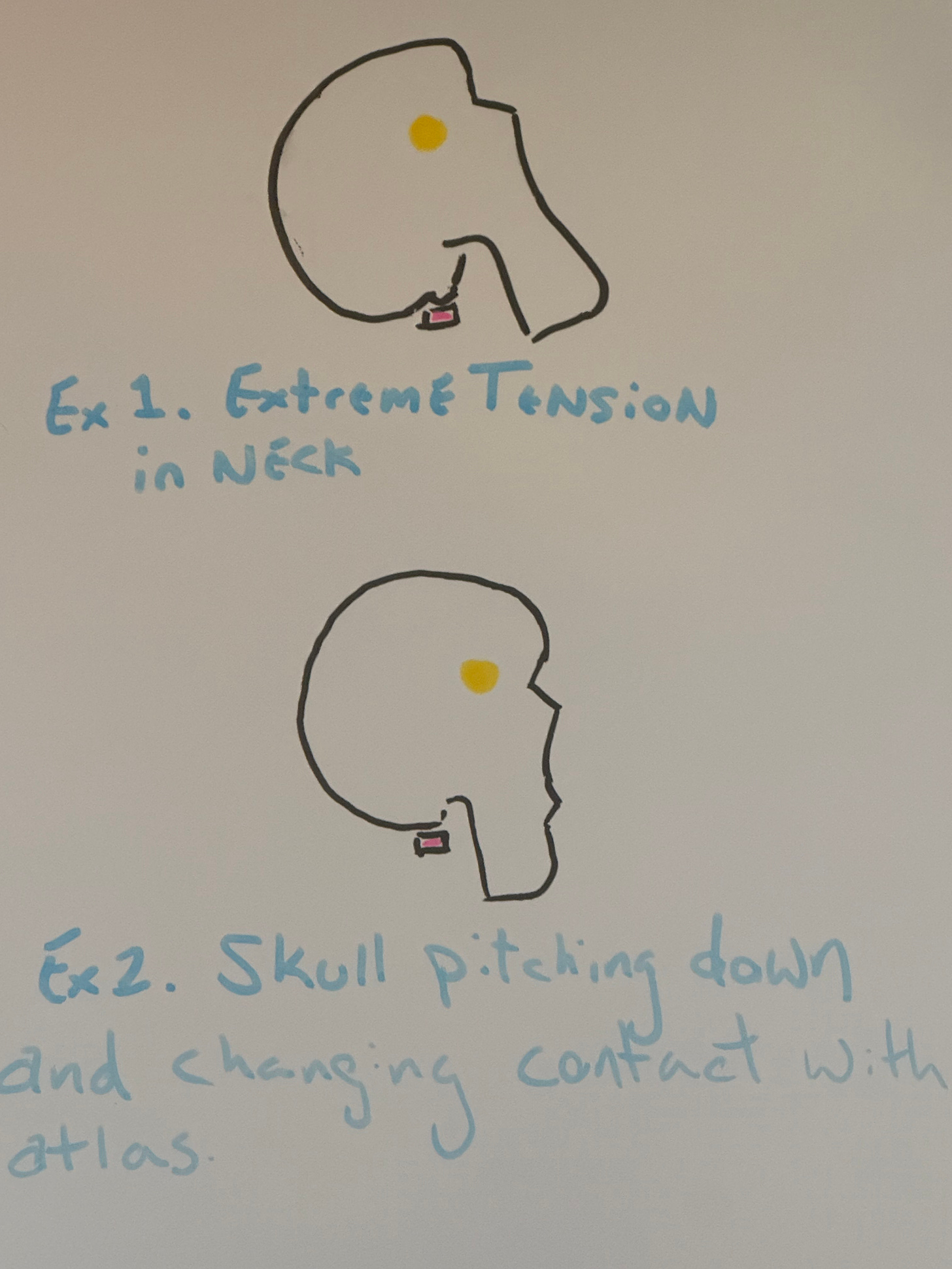This week I’m going to do something a bit rash… I’m going to share a rough draft of an essay I’ve written for my students. This essay gives instructions on how to allow the the neck to free. It’s something that I would include in a Little Book.
To date, each of my students has been able to read this essay, understand, and actually observe the things that I suggest they should observe. The massive caveat with this essay is that I have always been present to answer questions and make demonstrations where necessary. With this in mind, I am at least sharing it with you all so that if you have had a lesson with me, you will have a reminder of a very important lesson!
Part 1.
Allow the top of the trapezius to soften.
This is achieved by Looking Out, not holding your breath, and simply allowing your sense of feeling to sense the subtle and small relaxation of this region (either the big red zone in the picture above or the smaller blue zone within).
What begins to thaw may be bigger than just the initial region that you thought about.
If you cannot feel this muscle release at all…
You may find it is easier to stiffen this small spot so that you can sense what it is like to NOT stiffen it. What should feel possible is the ability to “dial up” the degree of stiffening in a smooth, slow, and controlled manner.
Purpose of Part 1.
This exercise is designed to teach the student the difference between forcing a muscle to relax and allowing it to relax. I have found that the initial and subtle release of a muscle is allowing and the follow through of effort to maximise release generates force.
Part 2.
What Does Softening the Top of the Trapezius Feel Like?
As the top of the trapezius softens, you may observe the that the skull begins to pitch down. This pitching may not happen for you if the top of your trapezius is relatively free. The remainder of Part 2 is a description of what I expect you will observe if the top of the trapezius is softening AND the skull begins to pitch down…
Being upright or lying down will change your relationship with gravity and thus change the degree and location of the shift of the skull with the top of the spine. It will always feel slightly different but it will always rhyme.
In the picture above, the yellow dot represents the centre of weight of the skull and the pink bone is the top of the spine AKA the atlas. The first skull is clearly drawn looking up at a 45 degree angle. This is my poorly drawn attempt at demonstrating an extreme version of neck tension. The second skull shows what I would expect to happen as the muscles in the Red Zone begin to soften.
Observations
If you are sitting or standing, the subtle release of the red zone will very likely cause the skull to pitch down a bit… perhaps no more than a single degree. The skull may also feel heavy as it begins to shift. If this happens, it is because your helicopter has come to a full landing on the neck and the weight of the skull is beginning to settle into the front portion of the atlas (pink bone). I would expect you to feel the back of the neck to soften and experience a glacial melting down the neck and out wide towards the shoulders to some limited extent.
In lying down, the contact with the front portion of the atlas does not occur unless the head is stacked very high on books. There exists a book height such that releasing the upper trapezius results in no discernible change in contact with the atlas.
Please note that this sensation of glacial melting is something that you did not COMMAND. It’s a thought and a damn subtle sensation. And it will never be more than a subtle sensation.
As you play with this exercise, you may notice that the neck stiffens up if your attention wanders. If that happens, don’t sweat it! You will likely feel some of your glacial melt disappear and you will be tempted to pick things up where you left off and resume the melt.
Instead, pat yourself on the back for noticing that the neck stiffened up again and go right back to the very beginning of this essay and have another go. You must go back to the beginning EVERY TIME because it is impossible to resume the melt where you left off.
EVERY time you feel the neck stiffen, you are to go back to the beginning.
EVERY. TIME.
But Wait! My Neck Is Still Stiff!!!
Absolutely. If you’ve followed these instructions to the letter (and I’ve done a decent job of describing this exercise), then your helicopter is well and truly landed on the neck. It is not flying. It is not forward and up.
The purpose of this essay is to observe all the feels for this one singular step and learn to associate the subtle muscular release at the top of the trapezius for what it is; a small sensation generated by pure, unforced thought. It will take you some time to learn to be satisfied with this small release, but I implore you to be satisfied with this. If you can learn to do this, then you can learn the entirety of the Alexander Technique.
From here, it takes some damn subtle and slow skill to allow your sense of feeling to drift up to the top of the helicopter (the green Mohawk in the first picture) while maintaining a soft red zone. Once your attention is in the green zone, you may find a particular way of achieving lift off with the head. You’ll find this adds a lot more glacial melt to the neck.
If this essay worked for you, please let me know!
If this essay confused the heck out of you, please let me know!
Get In Touch
If you’re in NYC, you may learn more about my private teaching practice at johndalto.com.
If you’d like to book any lesson time with me, you can find my booking link here.





For me- the "relaxing" happens more when feel that things are tight and I think about letting go of tight.
Another wonderful post that really supports my wing chun too. Thank you